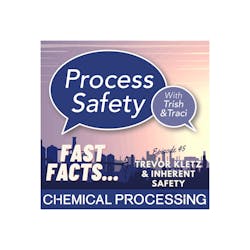Fast Facts Podcast: Trevor Kletz and Inherent Safety
Welcome to the Fast Facts edition of Process Safety with Trish and Traci -- the podcast that aims to share insights from past incidents to help avoid future events. I’m Traci Purdum, editor-in-chief of Chemical Processing.
Over the years and episodes, Trish and I have talked about inherent safety. Trevor Kletz pioneered the concept of inherent safety — explaining the approach in a landmark 1978 article "What You Don't Have, Can't Leak."
It suggests the most effective approach to process safety is the elimination of hazards where feasible. He pondered whether process plants really needed large quantities of flammable or toxic materials, whether less-hazardous materials could be used and whether it was really necessary to operate at hazardous conditions such as high temperature or pressure.
Indeed, he wrote an article for Chemical Processing on that very ponderance.
In that 2009 article, “Bhopal Leaves a Lasting Legacy” he started out commemorating the anniversary of the November 1984 incident: Twenty-five years ago this month, the worst accident in the history of the chemical industry occurred — a leak of highly toxic methyl isocyanate gas at a Union Carbide pesticide plant in Bhopal, India, killed thousands of people.
Industry learned many lessons; experts wrote many reports. But the story started in 1974, 10 years before Bhopal, when a large leak of hydrocarbon exploded at a Nypro plant at Flixborough, U.K., killing 28 people. The leak was large because only 6% of the hydrocarbon fed to the plant was converted; 94% had to be recovered and repeatedly recycled.
The most important recommendation made afterward was that we should look for ways to reduce the amount of hazardous materials in a plant, a process called intensification or minimization. The slogan was: “What you don’t have can’t leak.” This thought didn’t occur to most commentators or the official inquiry.
The Bhopal disaster wouldn’t have occurred if the plant managers had known about and then adhered to the recommendation made after Flixborough.
MIC wasn’t a raw material or product but an intermediate. Storing it was convenient but nonessential. It could have been used as it was made — then the worst leak would have been a few kilograms from a broken pipe rather than a hundred tons from a tank.
This time the chemical industry paid attention; within a year many companies had reduced or eliminated their hazardous intermediates stocks and used the materials as they made them.
There are four principles of inherently safer design and they are:
1. Eliminate the potential for harm (hazards);
2. Reduce the severity or scale of the consequences of the hazards;
3. Reduce the likelihoods of the hazards occurrence; and
4. Separate or protect people from the hazards
Kletz’s article continued: The “Don’t Have” concept can be applied more widely. If chemicals we don’t have can’t leak, people who aren’t there can’t be injured or killed. The human toll at Bhopal was so high because a shanty town had grown up near the plant. It’s difficult in a country like India to control development but necessary nevertheless to prevent people from living too close to hazardous sites.
A 2005 explosion at a BP refinery in Texas City, Texas, killed 15 people and harmed 170. One reason for the large number of deaths and injuries was that temporary buildings used by maintenance workers were close to the explosion site. If the buildings had been placed farther away from equipment containing hazardous materials — a recommendation that often has been made — the toll would have been lower.
Another illustration not included in Kletz’s article
The Piper Alpha disaster, which killed 167 people in July 1988. It is an example of an incident where many lives might have been saved by the implementation of principle 4. The Living Quarters of this platform were on top of what became a huge blow torch. If the living quarters had been on a separate platform, bridge-linked to the production platform, most would not have died. Therefore, if you cannot eliminate a hazard, then separate people from it.
Kletz was fond of repeating: "There's an old saying that if you think safety is expensive, try an accident. Accidents cost a lot of money. And, not only in damage to plant and in claims for injury, but also in the loss of the company's reputation."
Unfortunate events happen all over the world and we will be here to discuss and learn from them. Subscribe to this free podcast so you can stay on top of best practices – you can also visit us at chemicalprocessing.com for more tools and resources aimed at helping you run efficient and safe facilities. Thank you for listening to the Fast Facts edition of Process Safety with Trish & Traci
About the Author
Traci Purdum
Editor-in-Chief
Traci Purdum, an award-winning business journalist with extensive experience covering manufacturing and management issues, is a graduate of the Kent State University School of Journalism and Mass Communication, Kent, Ohio, and an alumnus of the Wharton Seminar for Business Journalists, Wharton School of Business, University of Pennsylvania, Philadelphia.

